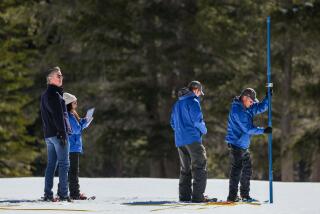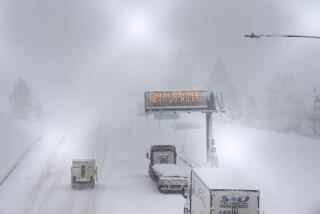So predictable?
- Share via
UNTOLD millions of dollars are spent each year in this country just trying to tell which way the wind will blow. Even with the most capable tools -- a supercomputer, a weather stick, a groundhog -- most meteorologists are leery of making long-term predictions.
Too many variables, especially in the West, where a combination of factors -- air and ocean temperature, moisture, air pressure and shifts in the jet stream -- come into play.
“You have to take these things with a grain of salt,” says Robert Fovell, an associate professor of atmospheric sciences at UCLA. “It’s their best guess of what can happen in the next three months.”
So how do we know whether there will be serious snow this year in California and the Rockies?
“It’s almost a no-brainer to say that this winter will be drier than last winter,” says Mike Halpert, head of forecast operations at the National Oceanic and Atmospheric Administration’s Climate Prediction Center.
Like most meteorologists, he’s playing it safe. But here are some indicators to see whether this will be a good ski season.
Acorns. California’s Chumash Indians believe that the more acorns that fall, the wetter the following winter will be. Some scientists, not wanting to leave anything to chance, have been monitoring the annual drop. According to Bill Patzert, a research oceanographer at NASA’s Jet Propulsion Laboratory in La Canada Flintridge, the acorn count was heavy before last year’s near-record winter. This year, the drop has been paltry.
Rex Block. When the Rex forms its eponymous “block,” it disrupts the usual high and low pressure systems that form at sea. Last year, it altered the typical east west airflow along the West Coast; the result was a “half figure eight” pattern that shifted the jet stream from the Gulf of Alaska south to Southern California. So far, there is no evidence of a Rex Block party this winter.
The Euro. Snow or no snow, some resort business owners say the best indicator of a good ski season is the economy and strength of the American greenback. Eunie Lyle, owner of the Blue Angel Cafe at the Heavenly Ski Resort in South Lake Tahoe, says that with a weak dollar, California is a good deal for Europeans. She says many European tourists book California ski vacations a year or more in advance. “They are coming,” she says. “They have paid already.”
The supercomputer versus the numbers. Climatologists can’t agree on the best method for making predictions. Some prefer a “dynamical method,” which relies on supercomputers to create weather models. Other scientists rely on a “statistical method,” which averages weather statistics over many years. The jury’s still out for this year’s numbers.
Pacific decal oscillation. What sounds like something you might stick on your snowboard actually refers to a long-term ocean fluctuation. Ocean temperatures and water elevations in the North Pacific alternate every 20 to 30 years. Patzert believes we have just entered a “neutral” or “cool” phase of the PDO, which is characterized by cooler water and cooler air temperatures. Cooler periods, he says, tend to mean drier conditions.
El Nino and La Nina. We all know the routine: One brings rain; the other brings drought. Both run in two- to seven-year cycles. A mild El Nino struck California in the winter of 2002-03, and climatologists don’t expect that pattern to return for at least a year.
Old Farmer’s Almanac. The almanac has been offering planting tables, zodiac secrets and weather forecasts since 1792. Its forecast for this winter season calls for warmer than normal temperatures through most of the state. The coldest temperatures will occur in early and late December. And the kicker? “Mountain snowfall will be below normal.”
Bottom line: A mild, slightly drier than normal winter in the Pacific Southwest. Patzert estimates this winter’s rainfall will be about 12 inches in downtown L.A., compared with the average 15 inches. He says offering such a definite prediction is “1 part science, 1 part experience and 1 part chutzpah.”
The answer: Snow-making machines. An industry buoyed by record snow last year has bet big on fans buying into a sequel. All over the West, resorts hoping to open early splurged on new snowmaking equipment, according to Wayne Ragland of Snow Machines, Inc.
His company and others are thriving on a quantum leap in snowmaking technology. Ducted fan snowmakers, with a compressor onboard, reduce energy use by two-thirds while producing more and fluffier snow. “What’s driving snowmaking is that people want to go early,” Ragland says.
*
Emmett Berg contributed to this report.
*
(BEGIN TEXT OF INFOBOX)
Cybersnow
Here are websites that tell you everything you need to know about snowfall in the West.
For complete listings in the state and the West, go to www.onthesnow.com.
For a variety of links to weather forecasts, go to bestsnow.net, by Tony Crocker, who supplies ski reports to The Times.
Resorts also post or link to weather at their websites. For the Tahoe region, go to www.snoweb.com. For Mammoth, go to www.mammothmountain.com.







